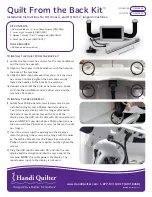
3
Important:
Sainre is not liable for damages arising from
improper use of its products or use that goes
beyond what the product is designed for.
1. Safety Guidelines
General
1. It is extremely important that you read through,
understand and follow all instructions in the
Owner’s Manual. Failure to comply with the safety
instructions may result in injury or death to the
user and/or the passenger(s) of the carrier.
2. Always comply with local safety regulations and local
Road Traffic Act. The safety regulations and/or Road
Traffic Act may restrict the use of the carrier in some
way.
3. This carrier is intended for carrying children during
daylight hours and travelling on light traffic roads,
sidewalks and smooth paths. Luggage may be added
in the designated area as long as
it doesn’t affect the
children’s comfort or safety.
4. If the bicycle trailer is to be used in conditions of poor
visibility, it must be equipmed with lighting devices
complying with the local traffic regulations. Two white,
non-flashing, lights must be installed on the tubes in
the front corners of the trailer and two, non-flashing,
red lights must be installed on the folding tubes in the
back of the trailer.
5. The passengers and cargo load must not exceed the
limits outlined in the specifications section.
6. Never carry dangerous cargo, fuel, heavy or sharp
items.
7. Always secure the luggage in the carrier. Unsecured
luggage may move thus making the carrier less
stable.
8. Only light items are to be placed in the inside pockets
or rear pocket. No cargo or load should be placed on
the seat or in the area forward of the seat.
9. The carrier is intended to be pushed by people or
towed by a bicycle. It must never be towed behind
motorized vehicles or animals.
10. No child should be in the carrier when connecting to
the bicycle, converting the carrier with the different
conversion kits, or when carrying out maintenance or
repair work.
11. Do not use on icy roads or in inclement weather.
12. Collapse and extend the carrier with care, there is a
risk of pinching your hand or fingers while doing so.
13. Before each use, check the tire pressure. The
pressure must be around 50 psi (3.45 bar).
14. Before each use, check that the wheels are fully
engaged.
15. Before each use, check that the folding locks are fully
engaged.
16. Regularly check all safety-related items for damage.
This includes; wheels, hitch arm, hitch, hitch plate,
stroller/jogger arms, handlebar, frame and plastic
components. If any damage is found, stop using the
carrier immediately until the part has been replaced
by your Authorized Dealer.
17. The recommended maintenance work is essential for
the durability and safe operation of the carrier.
18. Only use original replacement parts. Repairs and
replacements have to be carried out by an Authorized
Dealer.
19. Never make alterations, additions or modifications to
the carrier. This will make the carrier unsafe and
render the warranty invalid.
20. Regularly check for tears in the fabric. Fabric tears
represent a high safety risk. If you find a tear in the
fabric, stop using the carrier immediately and contact
your Authorized Dealer.
21. Installation of any equipment that does not carry the
approval of the manufacturer is not allowed. This
includes car seats, seat supports, luggage racks, etc.
22. Do not use the carrier at temperatures below -7°C
/20°F and do not store it below -20°C /-4°F as the
windows may become damaged and/or break. Tires
should not be stored in contact with windows as
window discoloration may result.
Transporting Children
1. You must comply with the weight and height limits
outlined in the specifications section of this user’s
manual.
2. Children should never be left unsupervised in the
carrier and should be checked on frequently to make
sure they are safe and comfortable.
3. Children should be clothed appropriately for the
weather.
4. If only one child is being carried in a two-seater
carrier, the central sitting position must be used.
5. Children and cyclist must wear approved helmets
(CPSC or CE approved).
6. Children must be at least 6 months old and be able to
sit up unassisted in order to be transported in the
carrier.
7.
No part of the child’s body, clothing or toys should
come into contact with the carrier wheels or the rear
wheel of the towing bicycle.
8. Always use th
e carrier’s cover to protect children from
insects and/or flying debris.
9. Never carry animals together with children.
10. Make sure the child does not bounce, fidget or lean
out of the carrier.
11. Fasten seatbelts correctly around the child and
correctly adjust to the height of the child.
12. Always have the parking brakes engaged as children
get in and out of the carrier. The parking brakes
prevent the carrier from accidentally rolling away.
Bicycle Trailer
1. Towing a trailer will negatively influence the braking
distance of the bicycle. Avoid sudden braking,


































